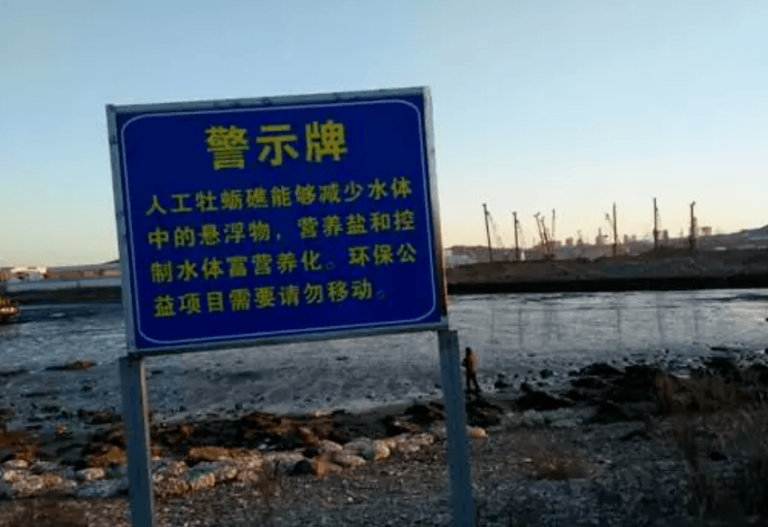
By Zhipeng Wang and Shengwei Zeng of Black Reef Coast Waterkeeper
In December 2015, Sirui Wang, Black Reef Coast Waterkeeper and long-time environmental advocate, initiated a discussion on how to solve ocean pollution with his colleagues Jing Zhu, Wenting Qiu and Shengwei Zeng. Utilizing their collective knowledge, they found that oyster reefs play a great role in water purification, maintaining marine biodiversity, protecting shoreline by absorbing the impact from waves, and many other important services.
The group went to Mr. Wen Bo to learn more. As an experienced environmental worker, then a Global Greengrants Fund (GGF) consultant, Mr. Bo described how many years ago there were abundant oyster reefs along the coastline of Dalian, a major city and seaport in Liaoning Province, China. Unfortunately, the number of reefs decreased sharply due to artificial exploitation and marine environment deterioration in the last decade. Mr. Wang realized that repairing the oyster reef in Dalian was of critical importance and would be advantageous to everyone in the region. Upon this realization, the Black Reef Coast Waterkeeper team switched their focus from managing coastal pollution in Dalian to restoring oyster reefs along the Liaodong Peninsula.

In April 2016, after many months of field investigation and studying oyster reef restoration cases at home and abroad, Mr. Wang, with partners Wang Zhipeng and Xu Weiwei, launched the Oyster Reef Restoration Project in Liaodong Peninsula with the goal of increasing coastal water clarity. The project received widespread approval, with supporters including was supported by Sun Kang, professor of Liaoning Normal University, and Sun Na, founder of Dalian No Shark Fin Foundation.
By May 2017, in addition to investigating oyster’s distribution on neritic rocks suitable for oyster growth, Black Reef Coast Waterkeeper had taken their studies to the next level and had begun conducting oyster reef restoration experiments in three locations. Their three sites included Heidao Island, Quanshui Wetlands and Heishijiao.

Xingshutun, a town off the coast of Heidao Island, had water pollution in the sea between the two mainlands caused by factory growth. Xingshutun has not yet been exploited by tourism, which made it a good location to establish an experiment. Black Reef Coast Waterkeeper began its pilot program back in October 2015. The researchers threw oyster spat, otherwise known as baby oysters, into the Heidao coastline to attempt to regrow the population there. This change was successful and not only improved water quality but brought economic opportunity to the locals by providing job opportunities for local fishermen and oyster distributors.


Part two of their experiment took place at Quanshui Wetlands, which at one point in time was a paradise for seabirds. But as the state of its environment worsened, the fantastic scenery and habitats disappeared. To attempt to remedy this, Black Reef Coast Waterkeeper put oyster shucks into bags and created man-made oyster reefs to be placed in circles along the coastline. After several months, they saw that the water quality inside the circle had improved – it was now better than that of the surrounding waters. To raise awareness of the ongoing experiment and its success, Black Reef Coast Waterkeeper placed a sign near the wetlands. To their delight, the government paid attention to the project and prepared to establish a wetlands park and sewage treatment plant for Quanshui Wetlands.


Currently, Black Reef Coast Waterkeeper is working with relevant government departments, the Dalian Nature Museum and domestic and international organizations to discuss additional methods of repairing the oyster reef. The project is moving forward steadily thanks to the work of Black Reef Coast Waterkeeper. This project will make a contribution to coastal protection and the ecosystem of the inshore sea area of Dalian and Liaodong Peninsula, as well as bring job opportunities to the locals, boosting the development of Black Reef Coast Waterkeeper’s local work. Everyone on the Black Reef Coast Waterkeeper’s team looks forward to, and is hard at work creating, a better ocean environment for all.
黑石礁守护者打造辽东半岛人工牡蛎礁修复项目
作者:王志鹏,曾胜伟
2015年12月,结合三年多的环保工作经历,黑石礁护水者王思睿在与团队成员朱静,邱雯婷及曾胜伟等讨论如何改善被污染的海水水质。结合他们所学的知识发现牡蛎礁对缓冲近岸海域冲击、净化水质、维持海洋生物多样性等方面具有独特而重要的作用。根据资深环境工作者,时任全球绿色资助基金会顾问温波描述,大连周边近岸海域曾经有大量的牡蛎礁。由于人工开发,海洋环境恶化等因素的影响,近十年来,牡蛎礁数量急剧减少。敏锐的王思睿觉得在大连,修复牡蛎礁具有得天独厚的条件。因此,专注大连海岸污染治理多年的黑石礁守护者团队决定开展牡蛎礁项目。

2016年4月,经过数月的实地调查,研究国内外人工牡蛎礁修复案例,黑石礁守护者王思睿及其团队成员王志鹏,徐巍巍在辽宁师范大学经济学教授孙康及大连“零鱼翅”基金发起人孙纳的支持下发起“通过修复辽东半岛牡蛎礁以净化沿岸水质”项目,在大连正式开展人工修复牡蛎礁工作。
至2017年5月,除了调研适合牡蛎生长的近岸岛礁的野生牡蛎礁分布情况外,黑石礁守护者团队选取大连的黑岛、泉水湿地和黑石礁三个地方同时实施人工牡蛎礁修复工作。

与黑岛相对的大陆地区是一个叫杏树屯的乡镇。大规模工厂开发,导致黑岛与杏树屯之间的海域受到严重污染。此外,该岛屿由于未被旅游开发而成为较好的试验地带。2015年10月,黑石礁守护者团队在黑岛周边海域相继投放约一万斤的牡蛎苗进行牡蛎礁修复试验。牡蛎礁的投放及试验地的维护,给当地居民带来一定的经济效益。


曾经的泉水湿地是海鸟们生活的天堂,但由于环境污染,栖息地破坏,海鸟数量大量减少。12月,在泉水湿地,黑石礁守护者将牡蛎壳放入麻袋,在海岸周围堆积成圈。一段时间后发现,牡蛎壳圈周边的水质比其他的水质要更好一些。黑石礁守护者在湿地旁立上警示牌呼吁并提醒人们保护海洋。终于,今年牡蛎礁项目引起了相关政府部门的关注。看到政府在湿地附近建立生态公园和污水处理厂,黑石礁守护者团队成员觉得很自豪。


目前,黑石礁守护者正积极地与大连相关政府部门,大连自然博物馆及国内外研究牡蛎礁修复工作的组织沟通联系,持续,稳步地推进大连牡蛎礁的项目进程。牡蛎礁项目,将对大连乃至整个辽东半岛的海岸防护,近岸海域的生态系统作业积极的贡献。同时,人工修复牡蛎礁为当地社区带来大量就业机会,推动黑石礁守护者社区工作的发展。